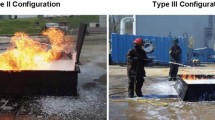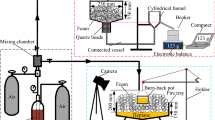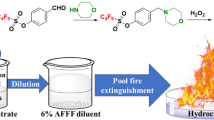Abstract
Aqueous film-forming foams (AFFF) have a long and successful history in industrial firefighting operations due to their unique properties allowing rapid knock-down of fires and efficient vapor suppression from large fuel surfaces preventing (re)ignition. However, all AFFF foams available on the market contain per- and polyfluorinated compounds which are expected to phase out in near future due to ongoing regulation. This paper summarizes foam testing of alcohol resistant AFFF (AFFF-AR) and fluorine-free alternatives (FFF-AR) in our company since 2001. It can be concluded that AFFF-AR foams’ performance has decreased in the past while at the same time, FFF-AR foams’ performance has significantly increased and some can be seen as replacements for AFFF-AR if correct application can be guaranteed.







Similar content being viewed by others
References
Hanen SW, Wagner DL (1993) US Patent Application US5391721A, Tyco Fire Products LP
Peshoria S, Nandini D, Tanwar RK, Narang R (2020) Short-chain and long-chain fluorosurfactants in firefighting foam: a review. Environ Chem Lett 18:1277–1300
Göckener B, Weber T, Rüdel H, Bücking M, Kolossa-Gehring M (2020) Human biomonitoring of per- and polyfluoroalkyl substances in German blood plasma samples from 1982 to 2019. Environ Int 145:106–123
Regulation (EU) 2019/1021 of the European Parliament and of the Council of 20 June 2019 on persistent organic pollutants. Official Journal of the European Union
Commission Delegated Regulation (EU) 2020/784 of 8 April 2020 amending Annex I to Regulation (EU) 2019/1021 of the European Parliament and of the Council as regards the listing of perfluorooctanoic acid (PFOA), its salts and PFOA-related compounds. Official Journal of the European Union
German Federal Institute for Occupational Safety and Health, Annex XV Restriction Report. Proposal for a Restriction: Undecafluorohexanoic Acid (PFHxA), its Salts and Related Substances (2019)
Hogue C (2020) EU agency to propose restricting PFAS in foams. C&EN Glob Enterp 98:17–17
European Commission, Commission Staff Working Document Poly- and Perfluoroalkyl Substances (PFAS) Accompanying the Document Communication from the Commission to the European Parliament, the Council, the European Economic and Social Committee and the Committee of the Regions Chemicals Strategy For Sustainability Towards A Toxic-Free Environment (SWD/2020/249) (Brussels, 2020)
United Nations, Montreal Protocol on substances that deplete the ozone layer, Decision IV/25 (1987)
Cousins IT et al (2019) The concept of essential use for determining when uses of PFASs can be phased out. Environ Sci Process Impacts 21:1803–1815
Allcorn M et al (2018) Paper presented at the Stockholm Convention POPRC-14. Rome
Bluteau T et al (2019) Paper presented at the Stockholm Convention COP-9. Geneva
European Commission DG Environment, European Chemicals Agency (ECHA), The use of PFAS and fluorine-free alternatives in fire-fighting foam (2020)
Peltzer E (2020) Comments of Werkfeuerwehrverband Deutschland on the restriction report for Undecafluorohexanoic acid (PFHxA), its salts and related substances as part of the public consultation on the restriction report
Persson H, Bobert M, Amon F (2016) ETANKFIRE - Fire extinguishing tests of ethanol tank fires in reduced scale. SP Rapport No. 2016:56
LASTFIRE (2016) Foam concentrate usage and options
LASTFIRE (2018) Evaluation of new generation firefighting foams for storage tank and associated facilities
Fire extinguishing media - Foam concentrates - Part 3: Specification for low expansion foam concentrates for surface application to water-immiscible liquids; German version EN 1568–3:2018
Fire extinguishing media - Foam concentrates - Part 4: Specification for low expansion foam concentrates for surface application to water-miscible liquids; German version EN 1568–4:2018
Peltzer E (2019) Fluorhaltige Schaummittel: Ein Paradigmenwechsel - Positionspapier Fluorhaltige Schaummittel. Fachzeitschrift des Bundesverbandes Betrieblicher Brandschutz, Werkfeuerwehrverband Deutschland 21:14–21
Back GG (2020) An evaluation of the firefighting effectiveness of fluorine-free foams. Fire Technology, New York
Fixed firefighting systems - Foam systems - Part 2: Design, construction and maintenance; German version EN 13565-2:2018+AC:2019
Haynes WM (2014) CRC handbook of chemistry and physics. CRC Press, Boca Raton, p 95
Heath MR, Henderson EW, Slesser G, Woodward EMS (1991) High salinity in the North Sea. Nature 352:116
Jones JE, Howarth MJ (1995) Salinity models of the southern North Sea. Cont Shelf Res 15:705–727
Appeltans W et al (2003) Zooplankton in the Schelde estuary (Belgium/The Netherlands). The distribution of Eurytemora affinis: effect of oxygen? J Plankton Res 25:1441–1445
Underwriters Laboratories Inc (2018) Standard for satefy, foam equipment and liquid concentrates, UL 162
Hinnant KM, Giles SL, Smith EP, Snow AW, Ananth R (2020) Characterizing the role of fluorocarbon and hydrocarbon surfactants in firefighting-foam formulations for fire-suppression. Fire Technol 56:1413–1441
Portable equipment for projecting extinguishing agents supplied by fire fighting pumps - Portable foam equipment - Part 3: Low and medium expansion hand-held foam branchpipes PN 16; German version EN 16712-3:2015
Fire-fighting pumps - Fire-fighting centrifugal pumps with primer - Part 1: Classification - General and safety requirements; German version EN 1028–1:2002+A1:2008
National Fire Protection Association (2021) Standard for low-, medium, and high-expansion foam. NFPA 11
Author information
Authors and Affiliations
Contributions
MK has since 2018 selected foam concentrates, designed the experiments, interpreted the results and written the initial draft. JF has worked up the data stored in print and digital archives and interpreted the results. GVB and RT selected foam concentrates, designed and supervised the experiments before 2018 and recorded the data. TE supervised the experiments in 2020.
Corresponding author
Additional information
Publisher's Note
Springer Nature remains neutral with regard to jurisdictional claims in published maps and institutional affiliations.
Rights and permissions
Springer Nature or its licensor (e.g. a society or other partner) holds exclusive rights to this article under a publishing agreement with the author(s) or other rightsholder(s); author self-archiving of the accepted manuscript version of this article is solely governed by the terms of such publishing agreement and applicable law.
About this article
Cite this article
Kaller, M., Van Bortel, G., Engels, T. et al. An Evaluation of the Firefighting Performance of Alcohol-Resistant Aqueous Film Forming Foams (AFFF-AR) and Alcohol-Resistant Fluorine-Free Foams (FFF-AR) in the Past Two Decades. Fire Technol 59, 429–452 (2023). https://doi.org/10.1007/s10694-022-01345-9
Received:
Accepted:
Published:
Issue Date:
DOI: https://doi.org/10.1007/s10694-022-01345-9




